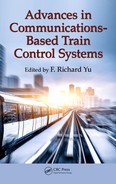
228 ◾ Advances in Communications-Based Train Control Systems
Combining Equations 10.14 and 10.19, the expectation of time delay without
hando can be derived due to the quality of the wireless channel.
T
fr frT
d
e
i
i
r
i
=
−
=
∑
0
()[1 ()]
α
(10.20)
Now we should consider the hando latency, which generally brings more eects
on the performance of train control. e hando procedure commonly consists of
three steps: scanning, authentication, and association, ended with one deauthen-
tication frame sent from the MS, as shown in Figure 10.6. ere are seven frames
transmitted before a complete hando procedure is nished: probe request frame,
probe response frame, authentication request frame, authentication response
frame, association request frame, association response frame, and deauthentication
Scanning
Authentication
Association
Probe request
Probe request
Probe response
Authentication request
Authentication
response
Association request
Association response
Deauthentication
Data packet
Data packet
Data packet
Data packet
AP2 AP1
MS
Triggering
conditions
Finish
Probe response
Figure10.6 Basic WLAN handoff procedure. At the beginning, MS communi-
cates with AP1. After the handoff procedure nished with one deauthentication
frame sent from the MS, MS communicates with AP2.

Cognitive Control for CBTC Systems ◾ 229
frame. As a result, the expectation of the time that a complete hando procedure
costs is about
7
T
d
e
. At the scanning step, if it happens that the broadcasting probe
request frame is successfully sent or there are some probe response frames received
by the MS, the MS will take the probe period time denoted as
T
period
to reach the
authentication step. However, each of the other ve frames cannot be transmitted
and a new hando procedure will be restarted, which will cost long time denoted
by
T
ne
w
for the MS to start a new hando procedure. As a result, the expectation of
hando latency with hando can be derived as
TprprTT
pr TT
h
e
d
e
d
e
=− −+
+− −+
(1 ()) {(1 ())(7)
[1 (1 ()) ](7
24
4
period
pperiod new
proc period
+
+− −− ++
T
pr pr TT T
d
e
)}
[1 (1 ()) ]{(1 ())(
7)
24
++− −+++[1 (1 ()) ](7 )}
4
pr TT TT
d
e
period proc new
(10.21)
where:
T
proc
is the time that the new AP and the MS take to build a new wireless link
Based on the comparison between the expectation of the communication delay and
the communication cycle
T
, we can get the reward function at each communica-
tion cycle according to the quadric cost (Equation 10.10).
r
xxQx xuRu G
GFxx xx
k
kk
T
kk k
T
kk
k
k
f
k
fc
T
k
f
k
fc
=
−−
++
=−
()
−
()
1
()()
β
(10.22)
where:
x
k
f
is the actual state (position and velocity) of the front train
x
k
fc
is the derived state of the front train from the MA from ZC by the current train
F
is a counter that indicates the quantity relationship of the total time delay and
the communication cycle, and it is dened as
F
TT
ii
T
T
TT
c
c
d
=
<=
<= <= >
1,
,1 ,
(10.23)
where
T
c
is the total time delay, and
F
decreases
1
at each communication cycle
during the time delay.
Specically, when analyzing the impact of the communication delay, both the
uplink delay and the downlink delay should be considered. Hence,
T
fd
e
and
T
fh
e
are
dened as the time delay (without any hando) and the hando latency of the
uplink. Similarly, the performance parameters of the downlink are dened as
T
cd
e

230 ◾ Advances in Communications-Based Train Control Systems
and
T
ch
e
.
x
k
is the desired state of the train, which includes the position information
p
k
and the velocity information
v
k
. e tracking error
xx
pp
vv
kk
kk
kk
−=
−
−
is determined by the uplink delay and the downlink delay. When ZC sends the
MA to the current train, the downlink delay directly aects the transmission
of the MA. However, MA is generated based on the information of the front
train, which means that the transmission of the MA is indirectly aected by the
uplink delay. Generally, at the rst communication cycle, the front train sends
its information to ZC and the current train gets the MA from ZC at the next
communication cycle.
As the communication delay without handos is determined by the retrans-
missions of one data packet, whereas the hando latency is related to the overall
hando procedure (seven frames), the communication delay (without hando) and
hando latency are not considered at the same time when we study the impacts of
time delay on the information gap. en, we dene
T
ch
e
=
0
or
T
fh
e
=
0
, when there
is no hando. Similarly,
T
cd
e
=
0
or T
fd
e
=
0
, when the hando procedure happens.
As a result, we take
TTT
d
ch
e
cd
e
=+
as the downlink delay and
TT
T
u
fh
e
fd
e
=+
as the
uplink delay. When
(/
)TT
u
<
1
, the information of the front train can be sent to ZC
in one communication period. When
(/
)TT
u
<1
, the MA can be received by the
current train in one communication period. As mentioned earlier, the MA is sent in
a communication period after the information of the front train is received by ZC.
en, the tracking error
∆
xxx
kkk
=−
is determined by one communication cycle.
However, when
(/
)TT
u
>=
1
or
(/
)TT
d
>=
1
, the scenario is complicated. We dene
=TT N
u
u
or
=TT N
d
d
, where
NN
u
∈
*
and
NN
d
∈
*
.
HN
k
d
d
∈[1
]
and
HN
k
u
u
∈[1
]
are the indicators of the current communication cycles during the
downlink delay and the uplink delay, respectively. Now we denote the acceleration
of the front train and the current train as
a
k
f
and
a
k
c
, respectively, and the velocity
as
v
k
c
and
v
k
f
. We can get the tracking error when the time delay is larger than the
communication cycle as follows:
∆
∆
∆
∆∆
x
p
v
pp
vv
pvT
k
k
k
kk
kk
kH
k
d
ikH
k
d
k
i
c
=
−
−
=
+
−
−
∑
=
=
++
+
−
−
∑
1
2
()
2
=
∆
∆∆
aT
va
T
i
c
kH
k
d
ikH
k
d
k
i
c
(10.24)

Cognitive Control for CBTC Systems ◾ 231
where:
Δ
a
k
c
is the dierence of the actual acceleration and the desired acceleration,
where the dierence is determined by
∆
∆
∆
xxx
p
v
k
f
k
f
k
fc
k
f
k
f
=−=
where:
Δ
p
k
f
is the distance that the front train runs during the time delay
Δ
v
k
f
is the velocity variant range of the front train during the time delay
e two variables are determined by
H
k
u
and
H
k
d
.
HH HH
pvTaT
v
k
u
k
d
k
f
jkHH
k
j
f
j
f
k
f
jkHH
k
=++−
=+
=
−
−
∑
∑
1
1
2
=
2
=
δ
∆
∆ aaT
j
f
()
(10.25)
where:
δ
is the overlapping number of communication cycles between the uplink delay
and the downlink delay
10.5 Simulation Results and Discussions
In the section, we present simulation results to show the performance of the pro-
posed cognitive control approach to CBTC systems. We rst present the details of
simulations, including the train dynamics, ATO, and wireless channel. Next, the
simulation results are discussed.
10.5.1 Parameters of Train Dynamics
According to train dynamics, the train state space equation can be written as
ppvT
u
M
T
w
M
T
vv
u
M
T
w
M
T
kk
c
k
kk
k
c
k
c
kk
+
+
=+
+−
=+ −
1
22
1
1
2
1
2
(10.26)
where:
M
is the train mass
w
k
is the resistance including slope resistance, curve resistance, and wind resistance
u
k
is the control command generated from ATO

232 ◾ Advances in Communications-Based Train Control Systems
As a result,
A
T
=
1
01
, B
M
T
M
T
=
1
2
1
2
, C
M
T
M
T
=
−
−
1
2
1
2
according to Equation 10.7.
10.5.2 Parameters of the ATO
According to Figure 10.5, formulae (10.7 and 10.8), ATO plays an important role in the
train operation, which gives the control command according to the state of two trains
y
k
,
which is dened as
ppvv
k
fc
k
k
fc
k
T
,, ,
, where
p
k
fc
and
v
k
fc
are the position and the velocity
of the front train derived from the MA received by the current train, respectively, and
p
k
and
v
k
are the actual position and velocity of the current train, respectively.
Based on the optimal train running prole in [28], we divide the train opera-
tion process into three steps: acceleration, coasting, and braking. As a result, there
are two switching points
sp sp
12
and . en, the ATO model of Equation 10.8 can
be converted as follows:
xB
yT
uCfx
k
cc
kc
k
c
k
c
+
=−
=
1
()
(10.27)
where:
TL
sp sp v
c
T
=
[]
,,,
12max
contains the constant parameters related to the subway line
and the design standard
L
is the safe distance, which should be kept between adjacent trains
v
max
is the maximum limited velocity of the subway line
B
c
=
−
11
00
01
00
01
00
00
01
(10.28)
As the train operation prole is partitioned into three parts, there are dierent control
schemes corresponding to each step. Generally, at the acceleration step, the accelera-
tion is a constant positive number to make the train reach the maximum speed as
soon as possible; at the coasting step, there is no power acting on the train, which
moves through inertia; at the last step, the train should brake with a constant decel-
eration until it reaches the safe stopping point. e control method can bring the
minimum energy consumption and the maximum eciency. However, considering
the system with two or more trains, due to the safe distance and the limitation of the
optimal running prole, if the distance between the adjacent trains is small because of
..................Content has been hidden....................
You can't read the all page of ebook, please click here login for view all page.
